|
Fly of
the Month
Bob Ireton brings together his
experience in fly fishing, aquatic entomology, and knowledge of fly
tying techniques and materials, to design and tie durable and
effective flies.
|

|

Volume 6, Issue 8
August 2005

GRAY FOX SQUIRREL HAIR NYMPH
By Bob Ireton
Several years ago, in fact, many years ago, Dave Whitlock developed a
killer nymph made using mostly the body hair of the Red Fox Squirrel. No
hair from the tail is used, as it is too coarse. Obviously, he named it
the ‘Red Fox Squirrel Hair Nymph’. I have found this fly to be very
effective on many species of fish.
In our area of Southwestern Ohio, there are a lot more Gray Fox
Squirrels than Red Fox Squirrels. I don’t see the skins of this squirrel
in the local shops, but the squirrels are seen everywhere. A tier could
easily get a skin from a hunting buddy, or if need be, on the road. Just
be advised, from my experience from hunting as a kid, and also from
having a pet Gray Fox Squirrel, they are always loaded with fleas!
I have taken the recipe for the Red Fox Squirrel Hair Nymph, and
modified it to tie the ‘Gray Fox Squirrel Hair Nymph’. This should be a
good fly to use when a ‘Gold Ribbed Hare’s Ear Nymph’ is a little too
dark.
MATERIALS
Hook – Daiichi 1710, TMC 5262, Orvis 1524, Mustad 9671, or
equivalent.
Size – 4-16.
Thread – Gray, 6/0 for larger sizes, and 8/0 for smaller sizes.
Weight – Lead wire, the same diameter as hook shank.
Tail – Gray Fox Squirrel back hair.
Rib – Small oval silver French tinsel.
Abdomen – Gray Fox Squirrel flank hair and gray antron dubbing,
mixed 50/50.
Thorax – Gray Fox Squirrel back hair and gray antron dubbing,
mixed 50/50.
Legs – Gray Brahma hen saddle soft hackle feather, or equivalent.
TYING STEPS - click on
pictures for larger view
|
1 – I am using a Daiichi 1710 hook in
size 10 for this fly. It has a nice ‘micro’ barb that is easier on the
fish’s mouth. You may mash down the barb, if desired. Place the hook
properly in the vice. Attach the thread behind the eye, and lay on a
good thread base. Stop at the hook barb, and tie a half hitch. Now wrap
several turns of lead wire in the thorax area. Vary the amount of weight
to the size of the hook, and how heavy you want the fly to be.. |
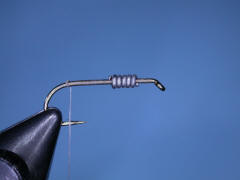 |
|
2 – Build a thread ramp on each end of the
lead. This will enable the materials to lay on smoothly. Also, cover the
lead with thread wraps, then bring the thread back to the ‘barb’ end of
the fly, and tie a half hitch. Cover the thread with Dave’s Flexament. |
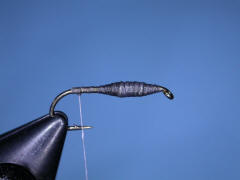 |
|
3 – Snip some hair from the back of the
squirrel skin, and use this to tie in a tail. It should be 1/2 to 3/4
the length of the shank. Snip off excess, and finish tying in. Tie a
half hitch. |
 |
|
4 – Cut a piece of the tinsel, and tie it in
on the end of the fly. Tie a half hitch. |
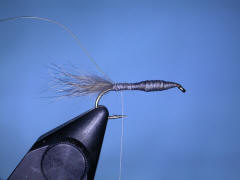 |
|
5 – Snip some hair from the flank of the
squirrel skin, and take a like amount of the antron dubbing, and mix the
two together. I use a spice mill to do this. Spin some of the dubbing on
the thread, then palmer it around the hook to form the abdomen. This is
approximately 2/3 of the length of the hook shank. Tie off, snip the
excess away, and tie a half hitch. |
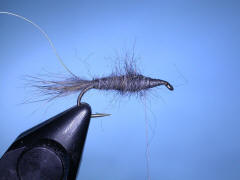 |
|
6 – Palmer the tinsel forward in spaced wraps to form the ribbing
on the abdomen. Tie down well, and cut off the excess tinsel. Tie a half
hitch. |
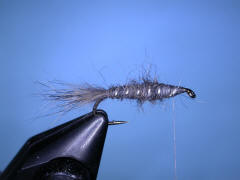 |
|
7 – Snip some hair from the back of the squirrel skin, and mix it
with a like amount of the antron dubbing. For the thorax, I like to use
a ‘dubbing loop’. Form the dubbing loop, and place some dubbing in it.
Twist the loop to form the dubbing rope. |
 |
|
8 – Palmer the dubbing rope forward, forming the thorax. Tie off
the rope, and cut off the excess. Tie a half hitch. |
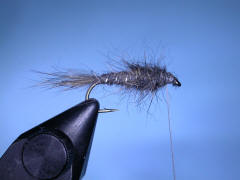 |
|
9 – Select the correct size soft hackle feather, and determine
which side will contact the fly when the ‘shiny’ side is facing forward.
Trim the feather fibers from this surface with the scissors. If you just
pull them off, it will also remove a ‘divot’ from the feather shaft,
making it weaker. Tie in the feather, and then tie a half hitch. Palmer
one turn around the fly, and tie it off. This will give us more than
enough legs and antennae! Snip off the excess feather, and tie a half
hitch. Form a nice head using the working thread. Tie a couple more half
hitches, then a whip finish. Snip off the thread, and apply some head
cement to the head. |
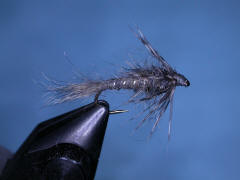 |
© 2005 Robert R. Ireton, II
www.buckeyeflyfishers.com
Site designed and maintained by
Panfalone@fuse.net
|









